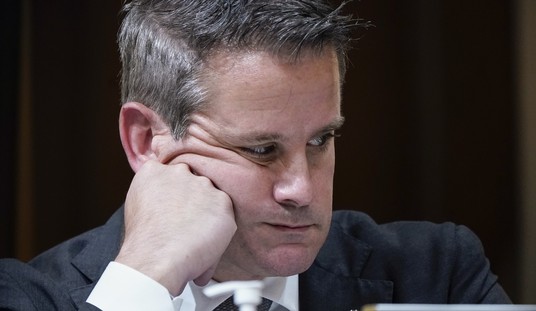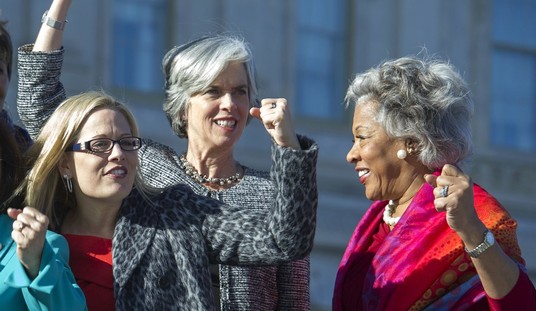After some 500 days of negotiation, the deed was done. On Thursday, February 9, attorneys general representing nearly all 50 states announced that five major banks – Ally Financial, Bank of America, Citibank, JPMorgan Chase and Wells Fargo – agreed to pay a combined $25 billion over three years in civil penalties and loan write-downs for having serviced mortgage foreclosure paperwork without proper review.
Supporters call the deal justice done, if not necessarily a full measure of it. Yet for reasons explained later, a better term would be “shakedown.” Outwardly, the agreement would compensate homeowners from predatory lending practices, reform the banking industry and give the economy a boost. Yet based on evidence, the ulterior goal is further socialization the housing market – as if that process already hasn’t been well underway.
The announcement comes just eight days after President Obama unveiled a broad policy initiative, “Plan to Help Responsible Homeowners and Heal the Housing Market.” The heart of the plan is a measure that would enable about 1 million “underwater” (having negative equity in their homes) mortgage borrowers current on their payments to refinance on favorable terms. The program’s projected cost of $5 billion to $10 billion would be covered by a Financial Crisis Responsibility Fee, originally set a year ago at $30 billion over 10 years but since boosted to $61 billion over that period. The latter represents 0.17 percent of a penalized financial firm’s assets. It’s a bank tax, though the President views it as a corrective to the financial industry’s “abdication of responsibility.” Regardless of interpretation, it will force banks to prop up mortgage borrowers in trouble. And it rests on the assumption that a homeowner has a right to remain indefinitely in his dwelling, however far behind on scheduled payments.
That’s pretty much the essence of the new agreement as well – as could have been predicted. The settlement has its origins in the formation of a 50-state working group in October 2010 led by Iowa Attorney General Tom Miller. Attorneys general and regulators sought to get to the bottom of a growing litany of reports that mortgage servicing operations had been prematurely signing off on foreclosure-related documents. The project, known as Mortgage Foreclosure Multistate Group, would investigate whether servicers recklessly glossed over information to facilitate foreclosures and whether they signed foreclosure affidavits outside the presence of a notary public, among other issues. “This is not simply about a glitch in paperwork,” said Miller at the time. “It’s also about some companies violating the law and many people losing their homes.”
Lenders at the time were growing frantic. Ally Financial, Bank of America and JP Morgan Chase only days earlier announced they had suspended foreclosures in nearly two dozen states in the wake of allegations of “robo-signing” by their own or contracted servicers. Wells Fargo had submitted additional affidavits for 55,000 pending foreclosures in those states, conceding there had been flaws in paperwork. And Bank of America began sifting through more than 100,000 foreclosure files to fix potential problems; most of the loans had been underwritten by the financially-troubled Countrywide Financial Corp., which BoA acquired in 2008 at the encouragement of the Treasury Department.
Recommended
All of this was occurring against the backdrop of the largest foreclosure crisis since the Great Depression. In 2010, the year the robo-signing revelations broke, foreclosure-driven sales accounted for around 30 percent of the nation’s residential sales, estimates the Irvine, Calif.-based RealtyTrac. That figure declined to 20 percent in 2011, a drop primarily owing to the reluctance of lenders to foreclose because of the scrutiny suddenly upon them.
A lot of troubled properties, in fact, remain in the pipeline, given that foreclosure filings can refer to default notices, scheduled auctions or bank repossessions. According the Jacksonville, Fla.-based Lender Processing Services, the nation’s largest contractor of residential foreclosure services (and a reason for the state probes), 4.29 percent of all active residential mortgages in the U.S. in October 2011 were in foreclosure, the highest figure on record.
The rapid upswing in foreclosures that began in 2008 was a wipeout for many home sellers, but it was a bonanza for companies handling the paperwork. With severely delinquent loans piling up, especially in fast-growing high-population states such as Florida and California, lenders recognized that foreclosure often was the only way to take non-performing loans off their books and bring properties back to market. The Obama administration’s Home Affordable Modification Program (HAMP), launched in the spring of 2009 to lower monthly payments, was making at best a modest dent in the foreclosure problem. Indeed, many homeowners had dropped out of the program during its initial phase.
Foreclosure is a complex legal process, typically taking months and often over a year. Processing all those extra documents required extra help. And mortgage servicers either couldn’t or wouldn’t hire that help. Overwhelmed by the growing caseload, several lenders and servicing operations took brazen short cuts, processing foreclosures without reviewing the details. At one point, GMAC Mortgage (now Ally Financial) was cranking out about 10,000 assembly-line affidavits a month.
Lawmakers, regulators and consumer advocates grew alarmed. Some took action. Interim Sen. Ted Kaufman, D-Del., chairman of a bipartisan congressional oversight panel looking into the Treasury Department’s foreclosure prevention programs, remarked that credibility problems in the foreclosure process “are already undermining investor and homeowner confidence in the mortgage market, and they threaten to undermine Americans’ fundamental faith in due process.” Phyllis Caldwell, head of the Obama Treasury Department’s homeownership preservation office, called the behavior of mortgage servicers “unacceptable.” The Office of the Comptroller of the Currency dispatched investigators to examine foreclosure operations at federally-chartered banks. Some judges in the New York City-area were dismissing anywhere from 20 to 50 percent of all foreclosure petitions because the paperwork was potentially inaccurate. And attorneys for a Baltimore-based nonprofit group, Civil Justice, filed a class-action suit to dismiss all Maryland foreclosure cases that involved a named robo-signer each for GMAC and Wells Fargo.
The states recognized a rare opportunity to reap the whirlwind. A tide of anti-bank populism was rising throughout the country, as banks and their servicing operations, far from denying they had operated foreclosure mills, were admitting as much. Attorneys general and other officials coaxed the five mega-banks to the bargaining table. The banks complied, knowing the alternative was a lawsuit. Negotiations began in October 2010; face-to-face talks began the following March. The Obama administration, especially in the form of Elizabeth Warren, then-acting director of the federal government’s new Consumer Financial Protection Board (and currently a Democratic candidate for U.S. senator from Massachusetts), made clear it was on the states’ side. For the banks, resistance was futile: They could pay now or pay a lot more later.
Banks initially offered $5 billion. That didn’t sit well with state negotiators, who refused to accept anything less than $20 billion. Some officials thought even that way too low. As the months dragged on, the 50-state coalition, unable to reach an agreement with the banks, drew close to disintegrating. Some states jumped the gun and went to court on their own. Massachusetts Attorney General Martha Coakley in December filed a civil suit against the five banks in negotiation, plus the Reston, Va.-based Mortgage Electronic Registration System Corp. (MERS), on grounds they “charted a destructive path by cutting corners and rushing to foreclose on homeowners without following the rule of law.” Three months later, early this February, New York Attorney General Eric Schneiderman sued Bank of America, JPMorgan Chase and Wells Fargo, claiming these banks used MERS to avoid paying recording fees and to disguise the true chain of ownership of foreclosed properties. Delaware Attorney General Beau Biden, son of Vice President Joe Biden, had sued MERS in October. And California and Florida were threatening lawsuits.
Eventually, with some late-hour help of Housing and Urban Development Secretary Shaun Donovan, the banks and the states got on the same page. President Obama did his part by soothing the nerves of holdout AGs. He invited Eric Schneiderman, along with California’s new Attorney General, Kamala Harris, to watch his State of the Union Address last month from the president’s box, next to First Lady Michelle Obama. (Schneiderman attended; Harris didn’t). Obama also appointed Schneiderman co-chairman of a new joint federal-state anti-fraud unit, to be run out of the Justice Department, focusing on mortgage-backed securities. By Monday, February 6, more than 40 states had committed themselves to a $25 billion deal. Some late concessions to Florida Attorney General Pam Bondi to dissuade her from filing suit eliminated the last real obstacle to the settlement, formally announced on the morning of February 9. In the end, 49 states signed on. Only Oklahoma said “no.”
Here are the fundamental details of the settlement. Five major banks, over a three-year period, will pay a combined $25 billion to: 1) borrowers of currently privately-held mortgages that had been issued during January 1, 2008-December 31, 2011; and 2) state programs. The banks also would have to institute industry reforms. The contributions break down as follows, in descending order of payment size: Bank of America, $11.82 billion; Wells Fargo, $5.35 billion; JPMorgan Chase, $5.29 billion; Citibank, $2.21 billion; and Ally Financial, $0.31 billion. Here is their intended destination:
$10 billion – mortgage principal reduction for an estimated 1 million households behind on their payments and owing more than their homes are worth.
$3 billion – loan refinancing for homeowners who are current on their payments but owe more than their homes are worth.
$1.5 billion – checks ranging from $1,500 to $2,000 to another 750,000 homeowners foreclosed upon improperly.
$7 billion – aid to state-sponsored homeownership programs.
$3.5 billion – direct aid to states.
In addition, Bank of America and its Countrywide subsidiary must pay $1 billion in damages to resolve a separate federal lawsuit involving these institutions’ inflation of home mortgage loan appraisals from 2003 through most of 2009. This side agreement explains why a number of newspaper accounts have cited the general settlement figure as $26 billion.
Supporters believe the deal will initiate an era of trust and integrity. Attorney General Eric Holder, for one, is satisfied. The agreement, he announced, “holds mortgage servicers accountable for abusive practices and requires them to commit more than $20 billion towards financial relief for consumers. As a result, struggling homeowners throughout the country will benefit from reduced principals and refinancing of their loans.” Iowa Attorney General Tom Miller, who led the states’ effort, similarly stated: “This agreement not only provides badly needed relief to Iowa borrowers, but it also puts a stop to many of the bad behaviors that contributed to the mortgage mess throughout Iowa and across the country. This agreement will protect homeowners and ensure they’re treated fairly.” And Richard Cordray, the former Ohio Attorney General whose anti-bank activism during negotiations helped secure him the job as director of the Consumer Financial Protection Board, also believes justice was done. “Today’s $25 billion settlement will help struggling homeowners across the country stay in their homes,” he remarked. “Under the terms of the agreement, the largest five servicers must adhere to new consumer protections and provide customers with options for avoiding the pain of foreclosure.”
Yet amid the hoopla of this “historic” agreement are some inconvenient realities. For the settlement was a product of populist enthusiasm driven by an image of rapacious, unscrupulous bankers throwing hundreds of thousands, if not millions of unsuspecting homeowners onto the streets. State and federal officials exploited the prevailing winds. Perhaps they should have listened more closely to the lone holdout, Oklahoma Republican Attorney General E. Scott Pruitt.
The following are some major downsides to the agreement.
First, the agreement is more expensive than its $25 billion price tag indicates. That Obama wants to double his proposed Financial Crisis Responsibility Fee is telling enough. But there are other, less overt signs. For one thing, the settlement doesn’t preclude other legal action. It doesn’t grant immunity from existing criminal charges or affect future criminal prosecutions. It doesn’t prevent homeowners or investors from pursuing either individual, institutional or class-action civil suits against the five banks. And it doesn’t prohibit state attorneys general or federal agencies from going after related aspects of suspect behavior within the mortgage industry. Finally, banks may receive only partial credit for what they spend on required activities. A spokesman for California Attorney General Kamala Harris explained that a bank may have to write down the value of a mortgage by an amount exceeding its market value. The true value of the settlement, given that consideration alone, he conceded, is more like $40 billion.
Second, even the $25 billion figure is unjustifiably high. Keep in mind that federal and state officials never questioned the necessity of the foreclosures, merely the manner in which they were processed. And while the banks’ cutting of corners undoubtedly was wrong, it was understandable. They were the end result of an explosion of paperwork related to mortgages underwritten to unqualified borrowers, often comically so. For years under pressure from Congress, regulators, and nonprofit community and civil-rights groups, many lenders (or their subsidiaries) significantly lowered risk standards in order to “reach” this bottom layer of homeownership demand. During his tenure as Ohio Attorney General, Richard Cordray accused banks of creating “a business model based on fraud.” But who exactly was defrauding whom? According to Lender Processing Services, 42 percent of all homeowners with loans in foreclosure – more than two in five – hadn’t made a single mortgage payment in the previous two years. “Robo-foreclosures” were a consequence of “robo-approvals” of unqualified borrowers.
Third, the deal is manifestly unfair, punishing responsible home mortgage borrowers and rewarding irresponsible ones, many in the latter category people who simply walked away from their properties rather than pay off debt on an asset with a declining value. Yes, declining property values caused a wave of foreclosures. But the dynamic works in reverse as well: Mass foreclosures were a major contributing factor to declining property values in certain communities. And it’s the most capable and conscientious of borrowers who holding the bag. Dick Bove, vice president of equity research at Rochdale Securities, “Homeowners who made large down payments on their homes or made the terrible mistake to pay down the principal on their mortgages do not qualify. Homeowners who made minimal or no down payments will get the windfall benefit of a lower principal repayment or a cash payment.”
Fourth, the deal further politicizes the housing market under the guise of “fairness,” creating what amounts to a mini-economic stimulus package minus the need for congressional approval. Bank shareholders and investors in mortgage-backed securities will do the paying; delinquent and/or undercapitalized homeowners will do the collecting. The $7 billion portion of the settlement going for state homeownership programs is especially susceptible to political capture. Anyone familiar with operations of homeownership programs at the state level knows that contractors as well as government employees are integral to running them. All would have a stake in keeping the flow of funds going, whether generated by taxes or coerced “agreements.” That this requirement might be a lucrative revenue source for ACORN-style nonprofit groups adds fuel to the fire.
Fifth, the settlement represents an abrogation of rule of law. It effectively tells people they can exempt themselves from contractual obligations if the right public officials go to bat for them. It functions as an amnesty. And like all amnesties, including those for people living in this country illegally, once granted, it will encourage the very kinds of behavior that led to it – reckless lending, avoidance of payments, “robo-signed” foreclosures, and coerced settlements. In a larger sense, we are evolving an economy based on moral hazard.
It’s hard to see the $25 billion settlement as anything but a shakedown. The fix was in from the start. Banks were presumed guilty. The question of the settlement was never “if,” but “how much.” If the lenders didn’t come to terms, they assuredly would have faced a multi-state lawsuit that would have cost them a lot more than $25 billion, possibly something in the neighborhood of the nearly $250 billion multi-state settlement with the tobacco companies in 1998.
In the final analysis, the source of the problem is the widely-held assumption that homeownership is a moral entitlement to be pursued regardless of consequences. This mindset is a bipartisan affair. Democratic and Republican state officials alike leaned hard on the banks. Democratic politicians at the national level such as Bill Clinton, Barney Frank and Maxine Waters helped create this crisis; so did Republican politicians such as George W. Bush, Newt Gingrich and the late Jack Kemp, each entranced by the prospect of an “ownership society.” Until we finally have the honesty to say that homeownership isn’t for everyone, more bank “scandals” such as this are likely to occur.

























Join the conversation as a VIP Member